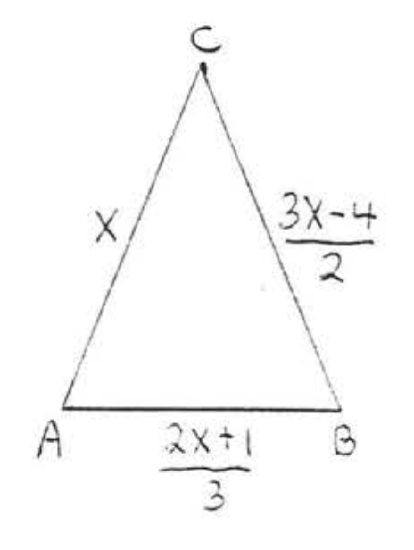1.6: Triangle CIassifications
- Page ID
- 34122
\( \newcommand{\vecs}[1]{\overset { \scriptstyle \rightharpoonup} {\mathbf{#1}} } \)
\( \newcommand{\vecd}[1]{\overset{-\!-\!\rightharpoonup}{\vphantom{a}\smash {#1}}} \)
\( \newcommand{\dsum}{\displaystyle\sum\limits} \)
\( \newcommand{\dint}{\displaystyle\int\limits} \)
\( \newcommand{\dlim}{\displaystyle\lim\limits} \)
\( \newcommand{\id}{\mathrm{id}}\) \( \newcommand{\Span}{\mathrm{span}}\)
( \newcommand{\kernel}{\mathrm{null}\,}\) \( \newcommand{\range}{\mathrm{range}\,}\)
\( \newcommand{\RealPart}{\mathrm{Re}}\) \( \newcommand{\ImaginaryPart}{\mathrm{Im}}\)
\( \newcommand{\Argument}{\mathrm{Arg}}\) \( \newcommand{\norm}[1]{\| #1 \|}\)
\( \newcommand{\inner}[2]{\langle #1, #2 \rangle}\)
\( \newcommand{\Span}{\mathrm{span}}\)
\( \newcommand{\id}{\mathrm{id}}\)
\( \newcommand{\Span}{\mathrm{span}}\)
\( \newcommand{\kernel}{\mathrm{null}\,}\)
\( \newcommand{\range}{\mathrm{range}\,}\)
\( \newcommand{\RealPart}{\mathrm{Re}}\)
\( \newcommand{\ImaginaryPart}{\mathrm{Im}}\)
\( \newcommand{\Argument}{\mathrm{Arg}}\)
\( \newcommand{\norm}[1]{\| #1 \|}\)
\( \newcommand{\inner}[2]{\langle #1, #2 \rangle}\)
\( \newcommand{\Span}{\mathrm{span}}\) \( \newcommand{\AA}{\unicode[.8,0]{x212B}}\)
\( \newcommand{\vectorA}[1]{\vec{#1}} % arrow\)
\( \newcommand{\vectorAt}[1]{\vec{\text{#1}}} % arrow\)
\( \newcommand{\vectorB}[1]{\overset { \scriptstyle \rightharpoonup} {\mathbf{#1}} } \)
\( \newcommand{\vectorC}[1]{\textbf{#1}} \)
\( \newcommand{\vectorD}[1]{\overrightarrow{#1}} \)
\( \newcommand{\vectorDt}[1]{\overrightarrow{\text{#1}}} \)
\( \newcommand{\vectE}[1]{\overset{-\!-\!\rightharpoonup}{\vphantom{a}\smash{\mathbf {#1}}}} \)
\( \newcommand{\vecs}[1]{\overset { \scriptstyle \rightharpoonup} {\mathbf{#1}} } \)
\( \newcommand{\vecd}[1]{\overset{-\!-\!\rightharpoonup}{\vphantom{a}\smash {#1}}} \)
\(\newcommand{\avec}{\mathbf a}\) \(\newcommand{\bvec}{\mathbf b}\) \(\newcommand{\cvec}{\mathbf c}\) \(\newcommand{\dvec}{\mathbf d}\) \(\newcommand{\dtil}{\widetilde{\mathbf d}}\) \(\newcommand{\evec}{\mathbf e}\) \(\newcommand{\fvec}{\mathbf f}\) \(\newcommand{\nvec}{\mathbf n}\) \(\newcommand{\pvec}{\mathbf p}\) \(\newcommand{\qvec}{\mathbf q}\) \(\newcommand{\svec}{\mathbf s}\) \(\newcommand{\tvec}{\mathbf t}\) \(\newcommand{\uvec}{\mathbf u}\) \(\newcommand{\vvec}{\mathbf v}\) \(\newcommand{\wvec}{\mathbf w}\) \(\newcommand{\xvec}{\mathbf x}\) \(\newcommand{\yvec}{\mathbf y}\) \(\newcommand{\zvec}{\mathbf z}\) \(\newcommand{\rvec}{\mathbf r}\) \(\newcommand{\mvec}{\mathbf m}\) \(\newcommand{\zerovec}{\mathbf 0}\) \(\newcommand{\onevec}{\mathbf 1}\) \(\newcommand{\real}{\mathbb R}\) \(\newcommand{\twovec}[2]{\left[\begin{array}{r}#1 \\ #2 \end{array}\right]}\) \(\newcommand{\ctwovec}[2]{\left[\begin{array}{c}#1 \\ #2 \end{array}\right]}\) \(\newcommand{\threevec}[3]{\left[\begin{array}{r}#1 \\ #2 \\ #3 \end{array}\right]}\) \(\newcommand{\cthreevec}[3]{\left[\begin{array}{c}#1 \\ #2 \\ #3 \end{array}\right]}\) \(\newcommand{\fourvec}[4]{\left[\begin{array}{r}#1 \\ #2 \\ #3 \\ #4 \end{array}\right]}\) \(\newcommand{\cfourvec}[4]{\left[\begin{array}{c}#1 \\ #2 \\ #3 \\ #4 \end{array}\right]}\) \(\newcommand{\fivevec}[5]{\left[\begin{array}{r}#1 \\ #2 \\ #3 \\ #4 \\ #5 \\ \end{array}\right]}\) \(\newcommand{\cfivevec}[5]{\left[\begin{array}{c}#1 \\ #2 \\ #3 \\ #4 \\ #5 \\ \end{array}\right]}\) \(\newcommand{\mattwo}[4]{\left[\begin{array}{rr}#1 \amp #2 \\ #3 \amp #4 \\ \end{array}\right]}\) \(\newcommand{\laspan}[1]{\text{Span}\{#1\}}\) \(\newcommand{\bcal}{\cal B}\) \(\newcommand{\ccal}{\cal C}\) \(\newcommand{\scal}{\cal S}\) \(\newcommand{\wcal}{\cal W}\) \(\newcommand{\ecal}{\cal E}\) \(\newcommand{\coords}[2]{\left\{#1\right\}_{#2}}\) \(\newcommand{\gray}[1]{\color{gray}{#1}}\) \(\newcommand{\lgray}[1]{\color{lightgray}{#1}}\) \(\newcommand{\rank}{\operatorname{rank}}\) \(\newcommand{\row}{\text{Row}}\) \(\newcommand{\col}{\text{Col}}\) \(\renewcommand{\row}{\text{Row}}\) \(\newcommand{\nul}{\text{Nul}}\) \(\newcommand{\var}{\text{Var}}\) \(\newcommand{\corr}{\text{corr}}\) \(\newcommand{\len}[1]{\left|#1\right|}\) \(\newcommand{\bbar}{\overline{\bvec}}\) \(\newcommand{\bhat}{\widehat{\bvec}}\) \(\newcommand{\bperp}{\bvec^\perp}\) \(\newcommand{\xhat}{\widehat{\xvec}}\) \(\newcommand{\vhat}{\widehat{\vvec}}\) \(\newcommand{\uhat}{\widehat{\uvec}}\) \(\newcommand{\what}{\widehat{\wvec}}\) \(\newcommand{\Sighat}{\widehat{\Sigma}}\) \(\newcommand{\lt}{<}\) \(\newcommand{\gt}{>}\) \(\newcommand{\amp}{&}\) \(\definecolor{fillinmathshade}{gray}{0.9}\)Triangles may be classified according to the relative lengths of their sides:
- An equilateral triangle has three equal sides,
- An isosceles triangle has two equal sides.
- A scalene triangle has no equal sides.

Triangles may also be classified according to the measure of their angles:
- An acute triangle is a triangle with three acute angles.
- An obtuse triangle is a triangle with one obtuse angle.
- An equiangular triangle is a triangle with three equal angles,
Each angle of an equiangular triangle must be \(60^{\circ}\), We will show in section 2, 5 that equiangular triangle are the same as equilateral triangles,

A right triangle is a triangle with one right angle, The sides of the right angle are called the legs of the triangle and the remaining side is called the hypotenuse,
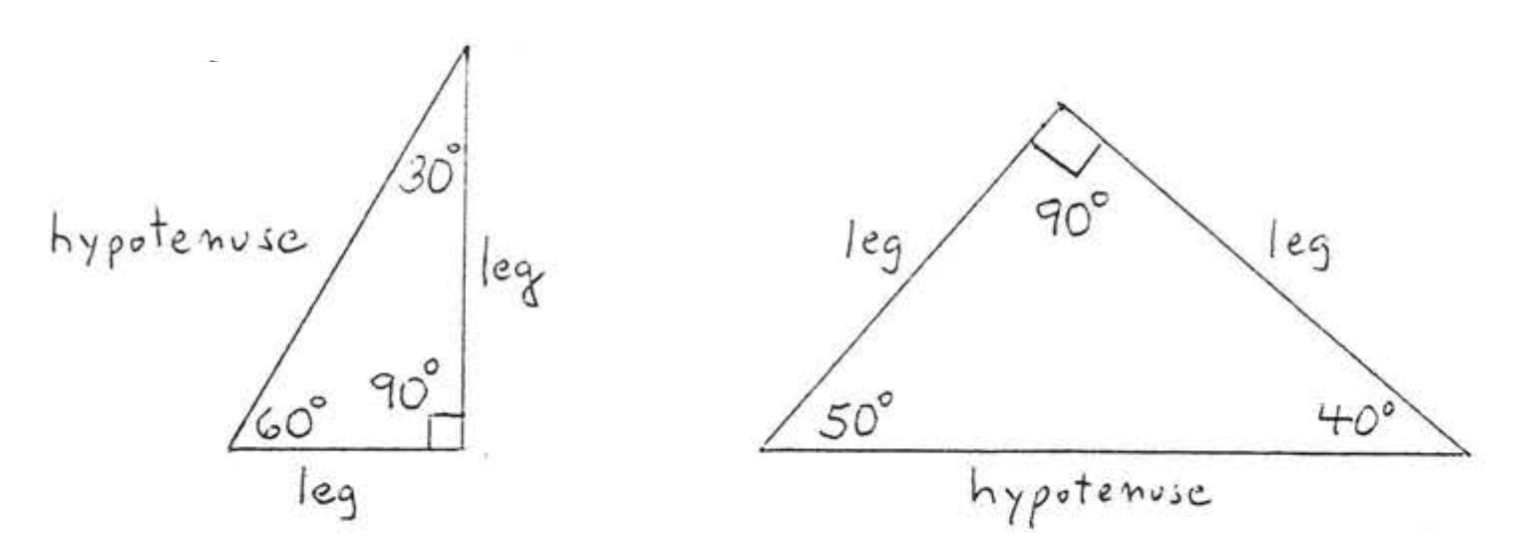
Find \(x\) if \(\triangle ABC\) is isosceles with \(AC = BC\):
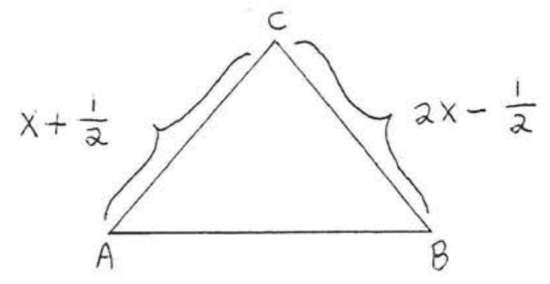
Solution
\[\begin{array} {rcl} {x + \dfrac{1}{2}} & = & {2x - \dfrac{1}{2}} \\ {(2)(x + \dfrac{1}{2})} & = & {(2) (2x - \dfrac{1}{2})} \\ {2x + 2 (\dfrac{1}{2})} & = & {(2)(2x) - (2) (\dfrac{1}{2})} \\ {2x + 1} & = & {4x - 1} \\ {1 + 1} & = & {4x - 2x} \\ {2} & = & {2x} \\ {1} & = & {x} \end{array}\]
Check:
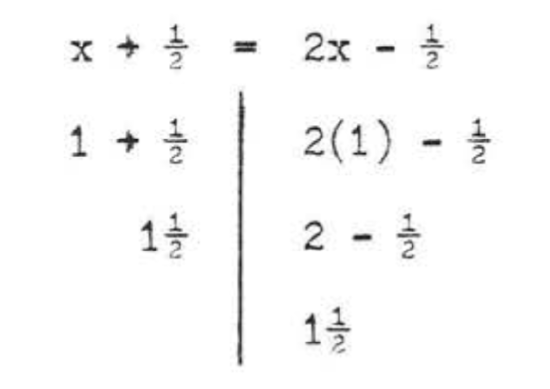
Answer: \(x = 1\).
\(\triangle ABC\) is equilateral. Find \(x\):
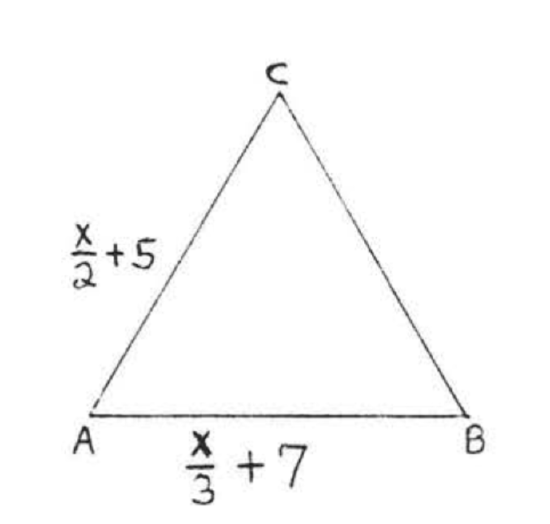
Solution
\[\begin{array} {rcl} {\dfrac{x}{2} + 5} & = & {\dfrac{x}{3} + 7} \\ {(6)(\dfrac{x}{2} + 5)} & = & {(6) (\dfrac{x}{3} + 7)} \\ {(6) (\dfrac{x}{2} + (6)(5)} & = & {(6)(\dfrac{x}{3} + (6)(7)} \\ {3x + 30} & = & {2x + 42} \\ {3x - 2x} & = & {42 - 30} \\ {x} & = & {12} \end{array}\]
Check:
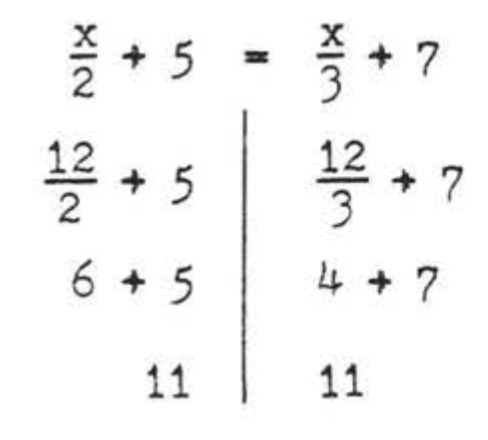
Answer: \(x = 12\).
An altitude of a triangle is a line segment from a vertex perpendicular to the opposite·side, In Figure 4, \(CD\) and \(GH\) are altitudes, Note that altitude \(GH\) lies outside \(\triangle EFG\) and side \(EF\) must be extended to meet it.
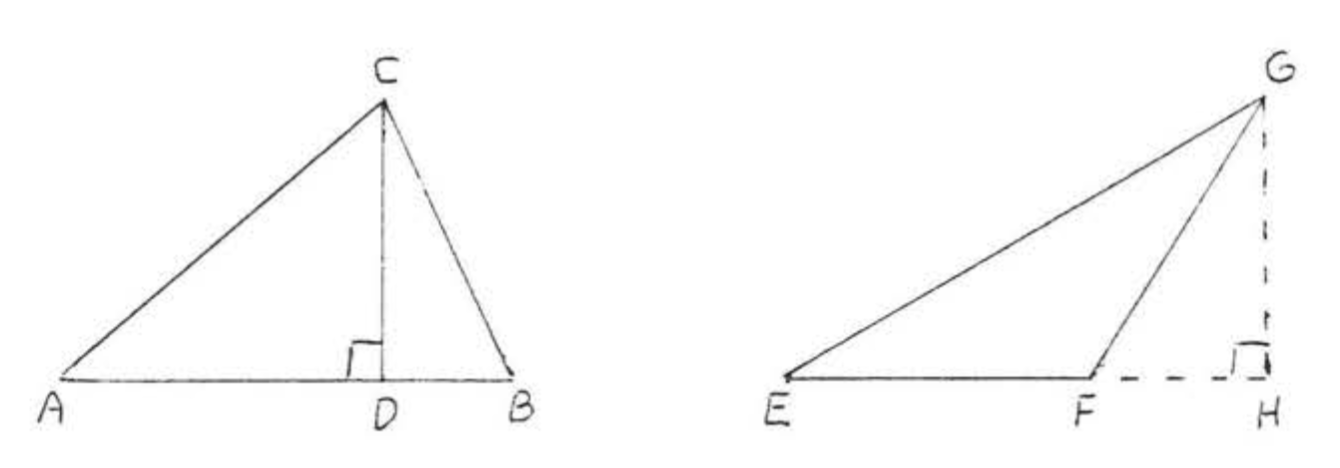
A median of a triangle is a line segment from a vertex to the midpoint of the opposite side, In Figure 5, CD is a median,
An angle bisector is a ray which divides an angle into two eaual angles. In Figure \(\PageIndex{6}\), \(\overrightarrow{CD}\) is an angle bisector.
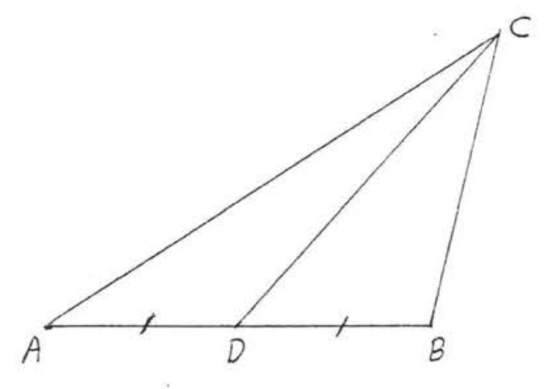
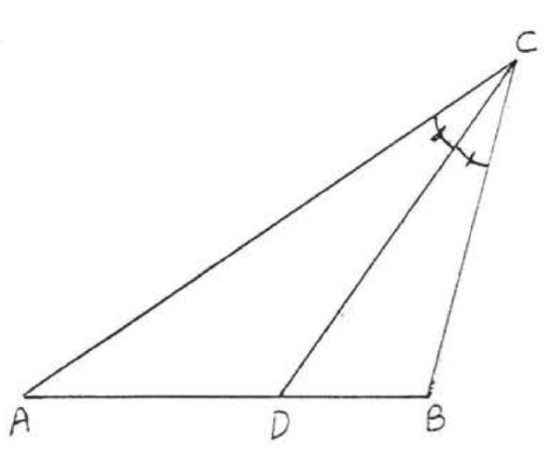
Find \(AB\) if \(CD\) is a median:
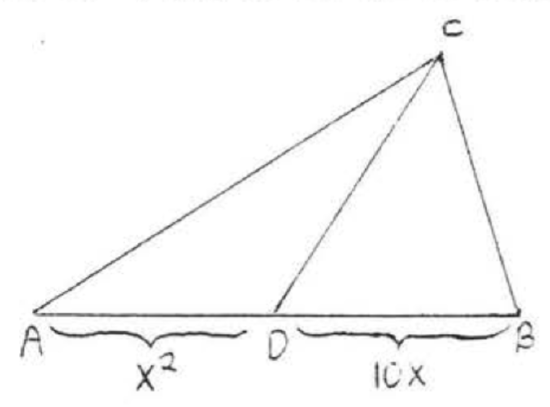
Solution
\[\begin{array} {rcl} {AD} & = & {DB} \\ {x^2} & = & {10x} \\ {x^2 - 10x} & = & {0} \\ {(x)(x - 10)} & = & {0} \end{array}\]
\(\begin{array} {rclcrcl} {x} & = & {0} & \text{ or } & {x - 10} & = & {0} \\ {} & & {} & \text{ } & {x} & = & {10} \end{array}\)
Check, \(x = 0\):
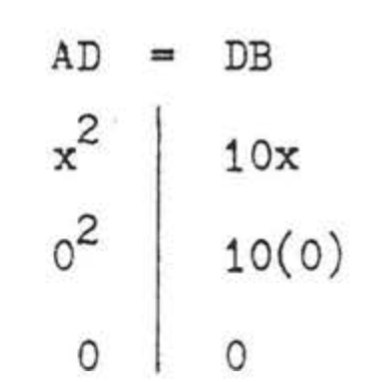
Check, \(x = 10\):
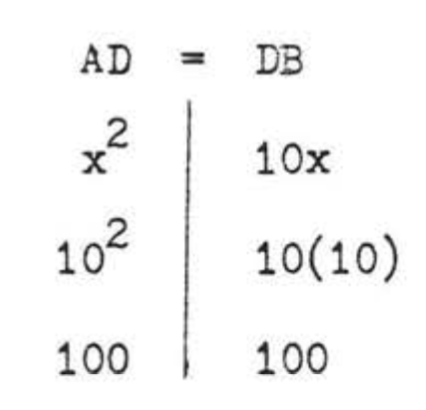
We reject the answer \(x = 0\) because the length of a line segment must be greater than 0, Therefore \(AB = AD + DB = 100 + 100 = 200\).
Answer: \(AB = 200\).
Find \(\angle ACB\) if \(\overrightarrow{CD}\) is an angle bisector:
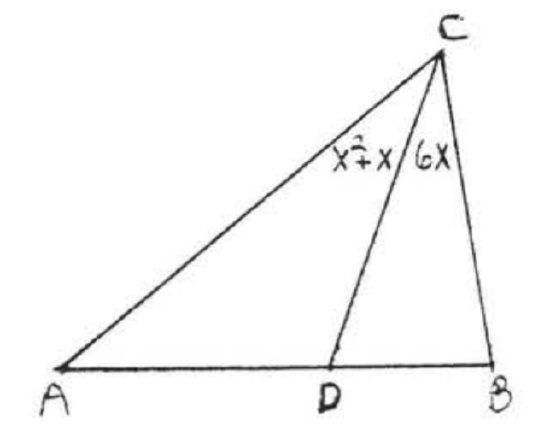
Solution
\[\begin{array} {rcl} {\anlge ACD} & = & {\angle BCD} \\ {x^2 + x} & = & {6x} \\ {x^2 + x - 6x} & = & {0} \\ {x^2 - 5x} & = & {0} \\ {(x)(x - 5)} & = & {0} \end{array}\]
\(\begin{array} {rclcrcl} {x} & = & {0} & \text{ or } & {x - 5} & = & {0} \\ {} & & {} & \text{ } & {x} & = & {5} \end{array}\)
Check, \(x = 0\):

Check, \(x = 5\):
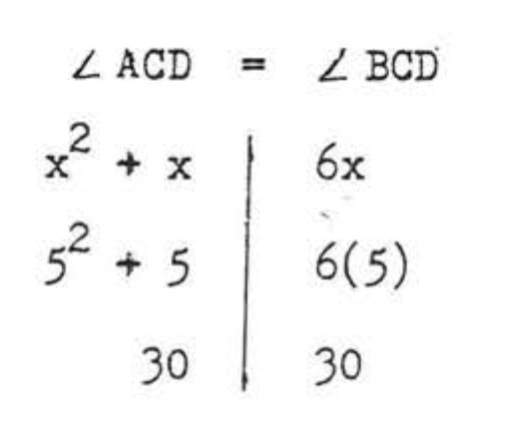
We reject the answer \(x = 0\) because the measures of \(\angle ACD\) and \(\angle BCD\) must be greater than \(0^{\circ}\). Therefore \(\angle ACB = \angle ACD + \angle BCD = 30^{\circ} + 30^{\circ} = 60^{\circ}\).
Answer: \(\angle ACB = 60^{\circ}\).
The perimeter of a triangle is the sum of the lengths of the sides. The perimeter of \(\triangle ABC\) in Figure \(\PageIndex{7}\) is \(3 + 4 + 5 = 12\).
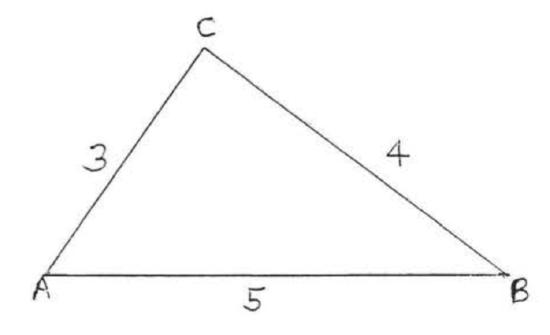
The sum of any two sides of a triangle is greater than the remaining side.
For example, in Figure \(\PageIndex{7}\), \(AC + BC = 3 + 4 > AB = 5\).
- Proof
-
This follows from the postulate that the shortest distance between two noints is along a straight line, For example, in Figure \(\PageIndex{7}\), the length \(AB\) (a straight line segment) must be less than the combined lengths of \(AC\) and \(CB\) (not on a straight line from \(A\) to \(B\)),
Find the perimeter of the triangle in terms of \(x\), Then find the perimeter if \(x = 1\):

Solution
\[\begin{array} {rcl} {} & = & {} \\ {} & = & {} \\ {} & = & {} \\ {} & = & {} \\ {} & = & {} \end{array}\]
If \(x = 1\), \(\dfrac{24 - x}{12} = \dfrac{24 - 1}{12} = \dfrac{23}{12}\).
Check:
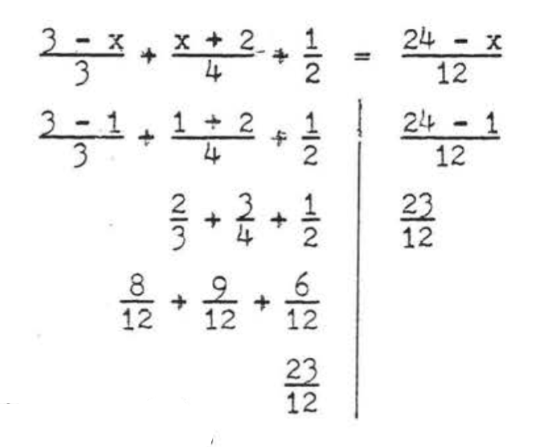
Answer: \(\dfrac{24 - x}{12}\), \(\dfrac{23}{12}\).
Problems
1 - 2. Find \(x\) if \(\triangle ABC\) is isosceles with \(AC = BC\):
1. 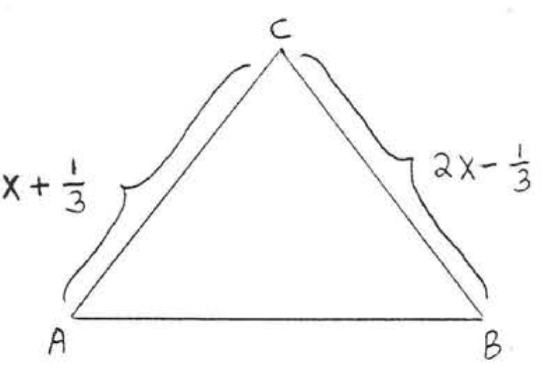 2.
2. 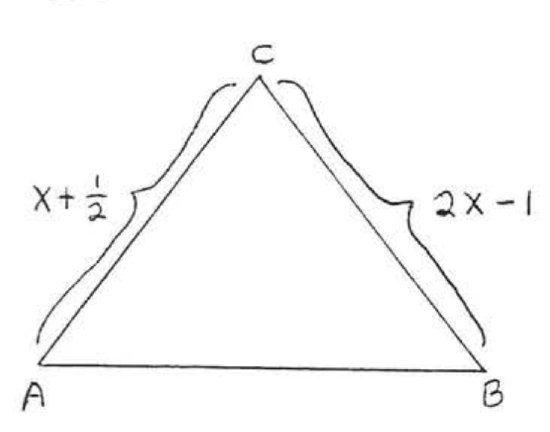
3 - 4. Find \(x\) if \(\triangle ABC\) is equilateral:
3. 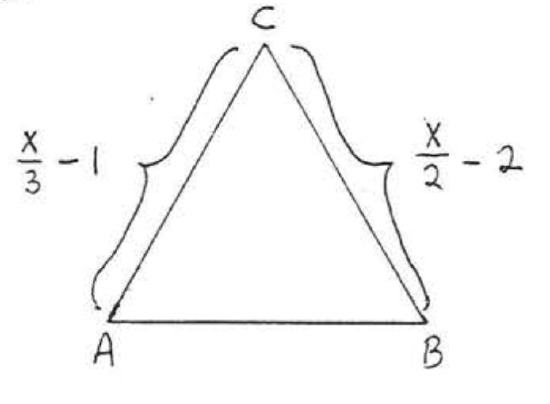 4.
4. 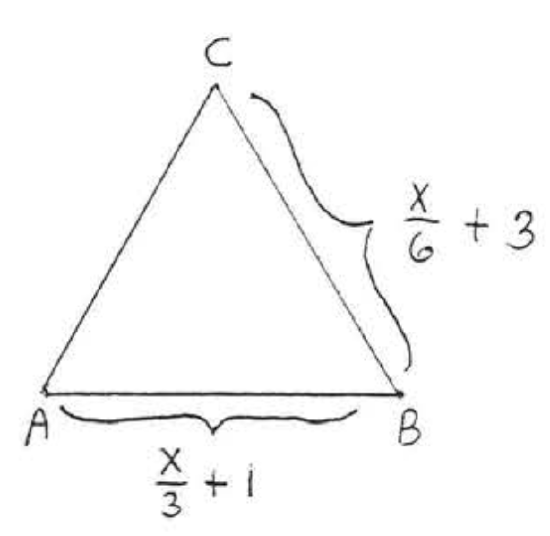
5 - 6. Find \(AB\) if \(CD\) is a median:
5.  6.
6. 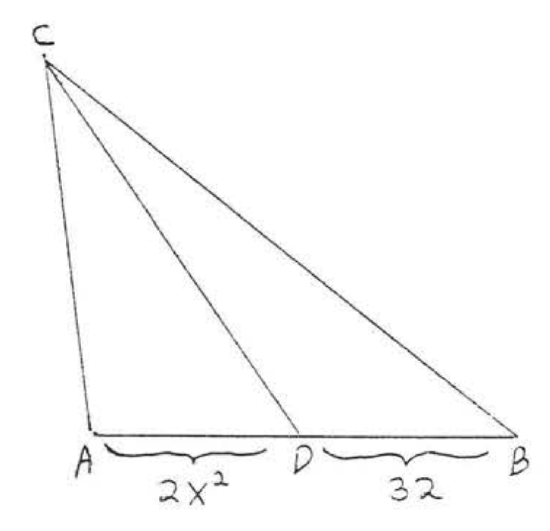
7 - 8. Find \(\angle ACB\) if \(\overrightarrow{CD}\) is an angle bisector:
7.  8.
8. 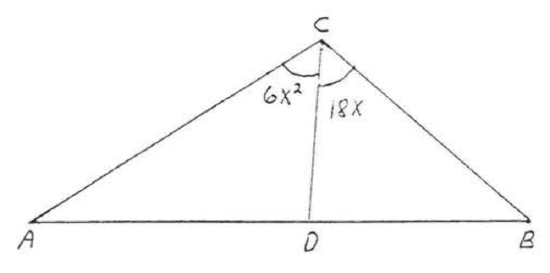
9 - 10. Find the perimeter of the triangle in terms of \(x\), Then find the perimeter if \(x = 4\):
9. 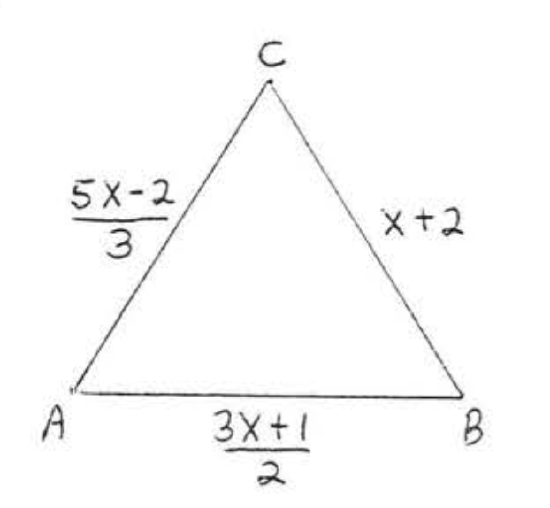 10.
10. 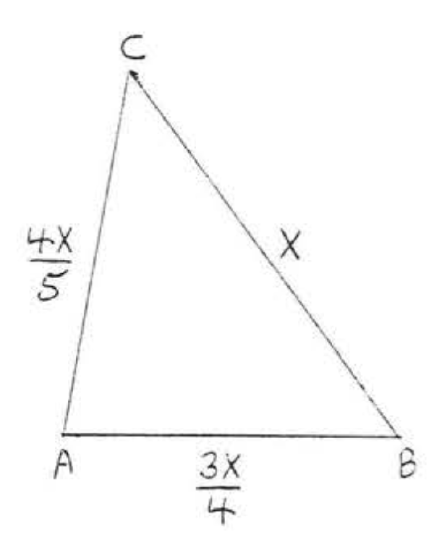
11. Find \(x\) if the perimeter of \(\triangle ABC\) is 33.

12. Find \(x\) if the perimeter of \(\triangle ABC\) is 11.
